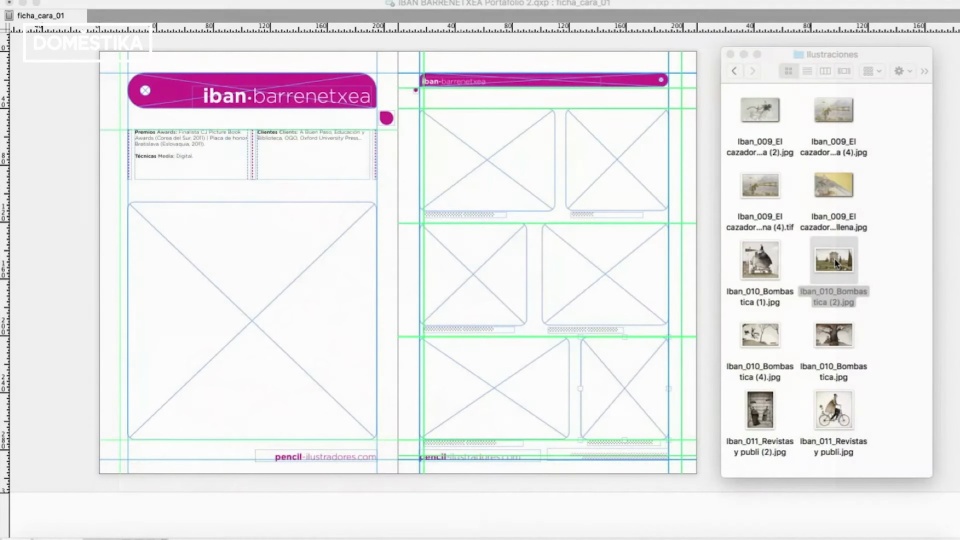Illustration Tutorial: how to create your first portfolio

Do you want to succeed by showing your work in the best possible way? Discover the tips to create a successful portfolio
When it comes to starting to prepare a portfolio, it is normal that doubts begin to assail us: how much of my work do I include? Will all my artistic production be up to par or should I select more? type of illustration is the most striking to convince potential clients?...
How we show ourselves as professionals to the world is essential, and having a portfolio that supports our potential as creatives is a basic step when it comes to building a career in the world of illustration. So here are some basic keys that will help you when you get down to work and create your own illustration portfolio.
1. Consider all categories of images
There are three main types of images that you will want to include in your illustration portfolio. This will help diversify the work you show and will also give it an interesting rhythm, since it will be diverse images with which you will avoid being too repetitive.
Finals

The finished illustrations, the fundamental basis of the portfolio.
Sketches

All the sketches that we have been creating as a prior step to the finished illustration should also be compiled. This way, we can show our particular creative process.
Application

That is, the illustration in its context, included in the work of which it was part. This way we can add value to the image, showing something more finished. Illustration is still an applied art, and must coexist with other elements. Therefore, it is good to show that we are capable of working with that overall vision.
2. How many images to include?

Not having enough images for the portfolio is one of the main concerns when starting to create it. But the important thing is not the number, but rather having a good selection of the best.
That is, it is better to include a small number of jobs with which we feel identified than a large number of irregular jobs. If you see that you are not able to defend any of these works, it is better to leave it out. In that sense, it is also not advisable to include works that are disconcerting: experimental illustrations that follow a completely different line from the rest of the samples in the portfolio.
3. How do I select my images?

The most important thing is to build a selection that conveys, above all, coherence, and in which all parts make sense in the portfolio, both separately and together. We need to show our work in a varied but logical way.
In addition, we must consider whether we want to include current illustrations or also some older ones, and if we are interested in combining different stages or styles within our career. The main illustration, for example, may be one that defines you at this point in your career, but you may be interested in introducing a more secondary one that shows a slightly different style, to show your range of talents. The important thing is that, whatever you choose, you continue to feel proud and consider that it represents you as a professional.
Another rule to follow is to look for variety in the elements represented: combining landscapes, characters... in a way that works can help show your skills in a broader way. In any case, these criteria are relative and in each case you can apply them differently when selecting your images.
4. One portfolio or several?

Depending on the sector we are targeting and the type of illustrator we are, we will be interested in having a single portfolio or having our separate production.
If you have a very marked personal style with which you can overcome what any sector may ask of you, you will surely be interested in showing all your work in a combined way. You will also need a single portfolio if you want to focus on a specific sector.
If, on the other hand, you are open to different types of assignments and think that combining your works could be confusing, you are probably right: art directors tend to get overwhelmed when they see many combined styles and tend to discard this type of portfolio quickly. In this case, you can separate your production by different categories or portfolios, depending on the sector you want to target.

If these tips on creating your portfolio have been useful to you and you want to continue learning about the subject, the online course 'Keys to creating a professional illustration portfolio', taught by the professionals of the PENCIL·ILLUSTRADORES illustration agency (@pencil), will help you turn your work into your best cover letter.
You may be interested
- Creative portfolio with own identity, a Futura course.
- Freelance: keys and tools to succeed being your own boss, a course by Martina Flor.
- Introduction to social networks for creative entrepreneurs, a course by Pamela Barrón.
- 'Branded content and content curation for your personal brand', a course by Carla González & Eva Morell.






0 comentarios